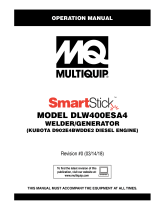
DLW330X2 WELDER/GENERATOR • OPERATION MANUAL — REV. # 1 (04/08/21) — PAGE 19
INSTALLATION
OUTDOOR INSTALLATION
If possible install the welder-generator in a area that is free
of debris, bystanders, and overhead obstructions. Make
sure the welder-generator is on secure level ground so
that it cannot slide or shift around.
The installation site must be relatively free from moisture
and dust. All electrical equipment should be protected
from excessive moisture. Failure to do so will result in
deterioration of the insulation and will result in short circuits
and grounding.
Foreign materials such as dust, sand, lint and abrasive
materials have a tendency to cause excessive wear to
engine and alternator parts.
INDOOR INSTALLATION
Exhaust gases from gas engines are extremely poisonous.
Whenever an engine is installed indoors the exhaust
fumes must be vented to the outside. The engine should
be installed at least two feet from any outside wall. Using
an exhaust pipe which is too long or too small can cause
excessive back pressure which will cause the engine to
heat excessively and possibly burn the valves.
PLACEMENT
This welder-generator should always be placed on a flat
level surface when it is running. DO NOT place the welder-
generator on slopes, the possibility exists that the unit could
slide.
WARNING
Pay close attention to ventilation when
operating the generator inside tunnels
and caves. The engine exhaust contains
noxious elements. Engine exhaust must
be routed to a ventilated area
DANGER
Electric shock can occur when vibrators
are used. Pay close attention to handling
when operating vibrators and always use
rubber boots and gloves to insulate the
body from a short circuit.
WELDER-GENERATOR GROUNDING
If applicable ,to guard against electrical shock and possible
damage to the generator, it is important to provide a good
EARTH ground, (Figure 3).
Article 250 (Grounding) of the NEC handbook provides
guidelines for proper grounding. It specifies that the cable
ground shall be connected to the grounding system of the
building as close to the point of cable entry as practical.
NEC article 250 specifices the following grounding
requirements:
1. Use one of the following wire types to connect the
generator to earth ground.
a. Copper 10 AWG (5.3 mm
2
) or larger.
b. Aluminum 8 AWG (8.4 mm
2
) or larger.
2. When grounding of the generator (Figure 3) is required,
connect one end of the ground cable to the ground lug
on the generator. Connect the other end of the ground
cable to the ground rod (earth ground).
3. NEC article 250 specifies that the earth ground rod
should be buried a minimum of 8 ft. into the ground.
NOTICE
The Occupational Safety and Health Administration
(OSHA) and the National Electrical Code (NEC)
recommend that if the welder-generator is providing
electrical power to a structure (home, office shop,
trailer or similar) it must be connected to a grounding
electrode system, such as driven ground rod (Figure 3).
NOTICE
ALWAYS check with State, Province, District and
Municipalities for electrical grounding requirements
before using generator.
NOTICE
When connecting the generator to any buildings
electrical system ALWAYS consult with a licensed
electrician.



























